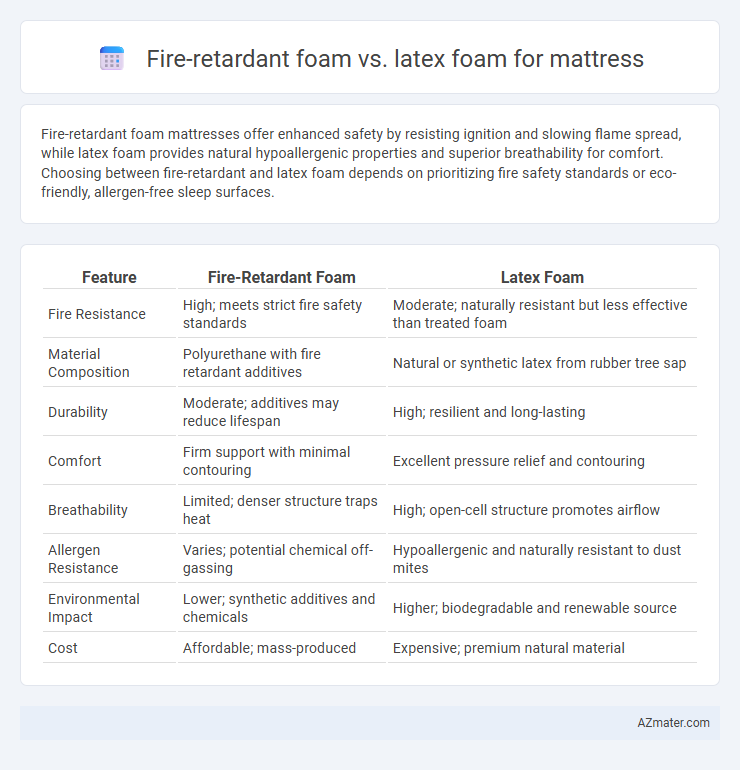Fire-retardant foam mattresses offer enhanced safety by resisting ignition and slowing flame spread, while latex foam provides natural hypoallergenic properties and superior breathability for comfort. Choosing between fire-retardant and latex foam depends on prioritizing fire safety standards or eco-friendly, allergen-free sleep surfaces.
Table of Comparison
| Feature | Fire-Retardant Foam | Latex Foam |
|---|---|---|
| Fire Resistance | High; meets strict fire safety standards | Moderate; naturally resistant but less effective than treated foam |
| Material Composition | Polyurethane with fire retardant additives | Natural or synthetic latex from rubber tree sap |
| Durability | Moderate; additives may reduce lifespan | High; resilient and long-lasting |
| Comfort | Firm support with minimal contouring | Excellent pressure relief and contouring |
| Breathability | Limited; denser structure traps heat | High; open-cell structure promotes airflow |
| Allergen Resistance | Varies; potential chemical off-gassing | Hypoallergenic and naturally resistant to dust mites |
| Environmental Impact | Lower; synthetic additives and chemicals | Higher; biodegradable and renewable source |
| Cost | Affordable; mass-produced | Expensive; premium natural material |
Introduction to Mattress Foams
Fire-retardant foam for mattresses is engineered with chemical additives that inhibit the spread of flames, enhancing safety standards in bedding products. Latex foam, derived from natural or synthetic rubber, offers superior elasticity and breathability, promoting pressure relief and temperature regulation. Both foams serve distinct purposes in mattress design, balancing fire safety requirements with comfort and durability.
What is Fire-Retardant Foam?
Fire-retardant foam is a specially treated type of polyurethane foam designed to resist ignition and slow the spread of flames, meeting strict fire safety standards such as those set by the U.S. Consumer Product Safety Commission (CPSC). This foam incorporates chemical additives that reduce flammability and help mattresses pass flammability tests without the use of heavy barrier fabrics. Unlike traditional latex foam, which is naturally resistant to flame but does not meet stringent fire codes, fire-retardant foam provides enhanced fire protection essential for compliance in many regions.
What is Latex Foam?
Latex foam is a natural or synthetic material derived from rubber tree sap, known for its durability, responsiveness, and hypoallergenic properties, making it a popular choice for mattress comfort layers. Unlike fire-retardant foam, which is treated with chemicals to resist ignition and slow flame spread, latex foam naturally resists dust mites and mold without the need for added fire-retardant chemicals. Its open-cell structure provides breathability and pressure relief, promoting cooler sleep and enhanced spinal support compared to denser, chemically-treated fire-retardant foams.
Composition and Material Differences
Fire-retardant foam typically incorporates chemical additives such as brominated or phosphorus-based compounds to meet stringent flammability standards, enhancing flame resistance but potentially compromising breathability and environmental safety. Latex foam, derived from natural or synthetic rubber, offers inherent fire-resistant properties due to its dense cellular structure without relying heavily on chemical treatments, maintaining better breathability and hypoallergenic qualities. The key material difference lies in the chemical-enhanced nature of fire-retardant foam versus the naturally resilient and eco-friendly composition of latex foam.
Safety Standards and Certifications
Fire-retardant foam mattresses often comply with the California Technical Bulletin 117-2013 (TB117-2013) standard, ensuring reduced flammability without harmful chemicals, while latex foam mattresses naturally resist ignition due to their dense, organic composition, often meeting OEKO-TEX Standard 100 certification for safety and toxin-free materials. Both types may adhere to CertiPUR-US certification, verifying low emissions and absence of harmful substances like ozone depleters and formaldehyde. Choosing mattresses with these certifications ensures compliance with safety regulations and promotes healthier indoor air quality.
Comfort and Support Comparison
Fire-retardant foam mattresses offer moderate support and firmness, designed primarily to meet safety standards, but may sacrifice some comfort due to denser, less breathable materials. Latex foam mattresses provide superior comfort through their natural elasticity and pressure-relieving properties, contouring closely to the body while maintaining strong support and responsiveness. In terms of durability and breathability, latex foam outperforms fire-retardant foam, resulting in a cooler, more comfortable sleep experience over time.
Durability and Longevity
Fire-retardant foam mattresses are engineered with chemical additives that enhance their flame resistance but may degrade faster over time due to these compounds, impacting overall durability. Latex foam mattresses, especially natural latex, offer superior resilience and bounce-back ability, resulting in long-lasting support and extended mattress lifespan. The inherent durability of latex foam typically exceeds that of fire-retardant foam, making it a preferred choice for longevity in mattresses.
Health and Environmental Impact
Fire-retardant foam mattresses often contain chemical additives like PBDEs, which have been linked to health risks including respiratory issues and hormone disruption. Latex foam, especially natural latex, offers a healthier alternative by being free from harmful flame retardants and is biodegradable, reducing environmental impact. Choosing natural latex foam supports better indoor air quality and sustainability compared to synthetic fire-retardant foams.
Price and Value Considerations
Fire-retardant foam mattresses generally come at a higher price point due to the added chemical treatments required to meet safety standards, impacting overall cost-effectiveness. Latex foam offers durability and natural resistance to allergens and dust mites, providing long-term value despite a higher initial investment. When comparing price and value, latex foam's longevity and eco-friendly composition often justify the premium over fire-retardant foam options.
Choosing the Right Foam for Your Mattress
Fire-retardant foam offers enhanced safety by meeting strict flammability standards, making it ideal for those prioritizing fire safety in mattress selection. Latex foam provides natural resilience, breathability, and hypoallergenic properties, suitable for sleepers seeking comfort and eco-friendly materials. Choosing the right foam depends on balancing fire safety requirements with comfort preferences and potential allergic sensitivities.

Infographic: Fire-retardant foam vs Latex foam for Mattress
 azmater.com
azmater.com